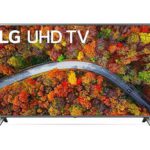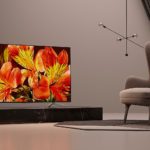*** TVReviewland.com earns commissions on qualifying purchases made through affiliate links ***
This Hisense U7G review looks at the features and performance of a ULED TV that promises maximum value for your dollar. Take a look at this review and find out what you should expect from this widescreen smart TV.
Hisense U7G review: ULED and quantum dot technology come together
ULED is an umbrella term for various technologies that execute a wide color gamut, excellent contrast, detail, and motion handling. Some of the displays that carry the ULED descriptor are LCD screens with a Quantum Dot layer. The Hisense U7G is one of them. Here’s what this means in terms of image quality and viewing experience:
Role of quantum dot technology in color accuracy and brightness
Quantum dot technology eliminates the need for the layer of yellow phosphorus that you find on most LCDs. This phosphorous layer shifts the backlight color from blue to white, absorbing some of the light in the process. The white light then passes through an LCD layer and an RGB color filter before appearing on the screen as a pixel.
As the backlight passes through multiple media, it loses brightness, which makes for a dimmer panel. The light also loses accuracy as the color filter and circuitry reproduce color for each pixel.
A quantum dot film does away with the need for a phosphorous layer. The film consists of millions of nano-particles that measure between two and ten nanometers. When light hits a quantum dot, the nano-particle emits light whose wavelength is a function of its size. Larger quantum dots produce light that tends to red, while smaller ones produce light that tends to blue.
The Quantum dot layer’s colors are brighter, more vivid, and more accurate than those from a traditional LCD panel. We’ll discuss picture quality in upcoming sections, and you’ll see how these principles figure into your viewing experience. With that, we take the TV out of the box.
[Read what others are saying about this TV]
Hisense U7G review: Design
It’s pretty normal to come across TV sets that are less than three inches thick, but the Hisense U7G isn’t one of those. At 3.54 inches, the U7G has a side-profile that starts off paper-thin at the top and thick at the bottom. A pair of non-removable cable clips add to the panel’s thickness. That being said, the TV will stay out of the way if you choose to mount it.
Let’s say you choose to set up the TV on an entertainment stand instead. There are four mounting points for the TV legs, allowing you to adjust the screen’s footprint. This comes in handy if your entertainment stand is narrower than the length of the TV.
The TV has a solid plastic chassis, with barely-there bezels on three sides and a more expansive, silver bezel at the bottom. The chassis becomes a black-and-grey panel at the back with a 300×200 wall mount pattern and two sets of inputs.
Ports and connectivity
The Hisense U7G has four HDMI ports, with two of those ports carrying HDMI 2.1 capability. It also has two USB ports and a digital optical audio output. You also get a 3.5mm audio jack, an Ethernet port, and a connector for your antenna or cable box.
A wireless adapter provides Bluetooth and dual-Band Wi-Fi connectivity. The TV allows for audio pass-through via the third HDMI port, which has ARC and HDMI 2.1 capability. This means that the TV can forward DTS and Dolby Digital audio to a connected sound device.
Smart TV interface
Android TV provides the U7G with a smooth, responsive, feature-rich OS. Thanks to the vast Google app store, you have your pick of streaming apps and useful productivity tools. Android TV is compatible with Alexa, in addition to its native support for Google Assistant. You can use the platform to convert your Hisense U7G into a smart home hub.
The panel’s far-field microphones allow you to summon the native voice assistant by saying, “Hey Google.” You can switch off the TV microphones with a physical switch that you’ll need to locate with the help of your Hisense user manual.
Hisense U7G review: Hardware and picture quality
The U7G is a VA panel that uses Quantum Dot technology to create exceptionally vivid, accurate colors. It is a 4K panel with direct array backlighting, local dimming, and a native refresh rate of 120Hz. These impressive specs already look promising, so let’s see what happens when we put the TV through its paces.
1. Color reproduction
Thanks to a wide color gamut and quantum dot technology, the Hisense U7G has perfect color reproduction right out of the box. Put the TV to the test by watching your favorite nature documentary and prepare to be awed. The blue-green colors of the sunlit ocean in paradise come alive in all their different shades, shadow, and sheen.
You don’t need to make any adjustments to the color settings of this TV.
2. Brightness, contrast, and HDR content
The panel has an impressive peak brightness level of 610 nits in SDR and 635 nits in HDR. As peak brightness levels go, the Hisense U7G makes the leaderboard, right along with the best TV sets in the market.
Bright televisions expand the range of colors that a display works with, creating rich, lifelike hues that look downright magical. This is the secret ingredient to accurate HDR content, along with dark, velvety blacks.
Thanks to local dimming and direct backlighting, pixels in the U7G get dark enough to create stark contrast. This translates to definition, detail, and texture; in bright, shadow, and dark scenes. This time around, the hapless prey in your favorite horror flick will be the only one to jump out of their skin. Excellent shadow detail will let you spot the smooth scales of the predator gliding silently in the inky-black waters of paradise.
3. Viewing angles
VA panels have famously narrow viewing angles, meaning color starts to wash out as you move from the center of the TV. In the same vein, the U7G gets dimmer as you move to the side, starting at an angle of 40 degrees.
4. Motion handling, gaming, and fast-action content
Again, the Hisense U7G outdoes itself when it comes to input lag and response times. It takes less than 15 milliseconds for a pixel to change colors, which works for all kinds of content. Add to this an input lag of 15ms, and you have yourself a gamer’s dream TV.
These numbers translate into minimal motion blur and a smooth, immersive experience during gameplay. The same goes for different types of content, like sports and other fast-action videos. Browsing the Android TV interface is also a pleasant experience due to low input lag.
The icing on the cake is the presence of variable refresh rate and GSync compatibility. There’s also HDMI 2.1 capability that allows gamers to play 4K, 120 fps game titles. It bears repeating that the Hisense U7G is a gamer’s dream.
Pros
- Excellent brightness levels and contrast
- Perfectly accurate color reproduction
- Hands-free voice assistant capability
- Four mounting points allow you to adjust the width of the TV legs
- Good motion handling, complete with VRR
Cons
- Narrow viewing angles
- The build quality could be better
- Far-field microphones in the TV may not be everyone’s cup of tea, so it’s a good thing you can disable them
Hisense U7G review verdict: Great value for your money
This Hisense U7G review finds a mid-range TV that easily competes with more expensive flagship models. Except for the narrow viewing angles, the Hisense U7G is everything you could want in a TV. Click here to learn more about this television.
Read more:
Sony X90CJ Review: The TV Comes as Advertised
Sony X81CH Review: An All-Purpose TV For a Fair Price
Sony X95J Review: Price Matches Performance
The Best 65-Inch TV Under $1000 2021




